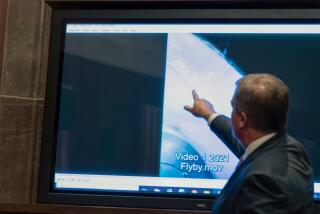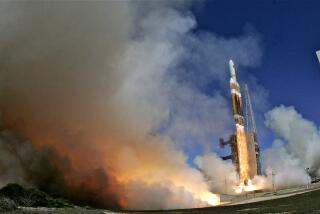Scientists Debate Merits of Manned Space Missions
- Share via
LA JOLLA — In May, 1958, a young American physicist placed a Geiger counter aboard the first U.S. satellite and interpreted the instrument’s steady clicking as evidence of a doughnut-shaped band of radiation encircling the earth. The belt was named in his honor, and James A. Van Allen went on to become one of the nation’s preeminent space scientists.
Another young American scientist developed precise methods in the late ‘50s for determining the history of meteorites in the solar system, eventually becoming one of the world’s authorities on lunar rocks. Chemist James A. Arnold heads the University of California Space Institute based at UC San Diego, and advises the federal government on space policy.
Both are stellar scientists, but they have strongly divergent views on the future of human beings in space. Their contrasting opinions served as the centerpiece for daylong seminars and presentations on that role Wednesday at UCSD.
“We’ve spent $150 billion on manned flight, and the results have been meager (in terms of scientific benefits),” Van Allen told a press briefing Wednesday. “There have been 133 different individuals on the flights, and that works out to about $1 billion per individual flown.
“The results have been nowhere vaguely near the expense of the enterprise.”
Van Allen contrasted manned flight with what he called the “magnificent advances” in scientific knowledge from automated (i.e., unmanned) flights of satellites and rockets, the cost of which has been about one-fifth that of manned exploration.
And Van Allen called for reappraisal of manned flight in light of the Challenger shuttle disaster in January.
“I think we need the existence of a healthy manned space program,” Arnold countered, calling exploration of space a fitting continuation of an urge to explore new frontiers that goes back to Christopher Columbus.
“It goes far beyond science and the simple gathering of knowledge. There is a deep, inherent drive (to explore) . . . in the human race and particularly among Americans,” Arnold said.
“The dreams of today can be the realities of tomorrow. If we look ahead, we can expect to see people living and working outside the earth and as a normal part of the human environment.”
The two men were joined by Thomas O. Paine, chairman of the National Commission on Space, and Noel W. Hinners, director of the National Aeronautics and Space Administration’s Goddard Space Flight Center. Paine was administrator for NASA’s first seven Apollo moon flights, including the first landing on the moon.
Paine and Hinners suggested that both manned and automated exploration can continue, but that the nation needs to understand clearly what should be accomplished by each method.
“It’s not necessarily man versus machine but how best to use people in space,” Hinners said. As the former director of the National Air and Space Museum at the Smithsonian Institution, Hinners said, he has especially noted the public’s enthusiasm and curiosity over placing humans in space.
“That (identification) can’t be felt simply by putting machines out there alone,” Hinners said.
Paine’s commission in May issued a report on a new long-range civilian space program that he said advocates continuing the human role in several ways. It emphasizes low-cost transportation, a greater use of robotics to enhance human tasks, and creating artificial environments on the moon and perhaps Mars that could use elements on those planets for energy, Paine said.






